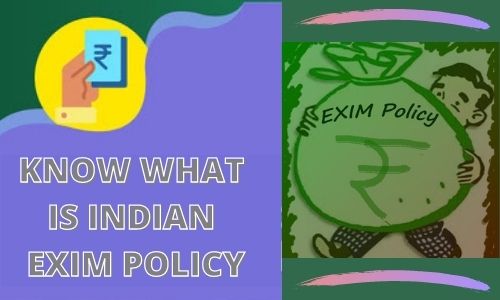Introduction to EXIM policy
Indian EXIM Policy, (Short of Export-Import Policy ) is a Foreign trade policy sets the guidelines for the export and import of the trade in the country by the DGFT ( Director General of Foreign Trade), The Department which is basically responsible for the regulation, acceleration and providing incentives on the promotion of Exports & to Insure smooths functioning of Exports and imports to and from India.

Features of Exim Policy
In other terms, the EXIM policy referred to as Foreign Trade Policy(FTP).FTP is facilitated and encouraged by the DGFT under the governance of the Ministry of Commerce and Industry(MOCI). DGFT is in charge of the Regulation and Promotion of Foreign Trade leads to accelerate and facilitate the Exports and Imports. Moreover, DGFT is also responsible for issuing the Authorizations to the Traders(Exporters/Importers) and various Export Incentives as well.
The main target behind introducing this EXIM Policy is :-
“To provide an ease to the country in terms of its manufacturing and services sector. With respect to this, India has introduced many new schemes for exporters from India including the MEIS and SEIS schemes.”
EXIM Policy Objective
The main theme behind introducing this EXIM Policy is to facilitate trade from India to Foreign countries at large. With this target, this policy offer information on its various schemes, applicable Governance, Procedure to avail the various incentives under MEIS, SEIS, and other schemes and the most importantly how to set a business in India. Moreover, the Government has provided the Redressal Forum with the intent to resolve the grievances of Traders instantly with no time-bound. This is the Exim policy of India where Promotion of the Export trade is encouraged with the appropriate policy.
EXIM policy in a business environment or EXIM policy in international business
It is an Export-Import policy updated every year on 31 March and is modified or improved. Accordingly, new schemes will be effectively applicable from 1st April of every year.
It is just to promote the international market with the attainment of high standards.
Function of the EXIM Policy
This Policy gets to finance the Import and export of goods and services from India. Not only this, Finance can also get done if Import and export are to be done other than India.
Governance
Under the Ministry of Commerce and Industry, the following Government Bodies and Agencies are involved.
>>DIRECTORATE GENERAL OF FOREIGN TRADE (DGFT)
>> DIRECTORATE GENERAL OF ANTI-DUMPING AND ALLIED DUTIES (DGAD)
>> DIRECTORATE GENERAL OF COMMERCIAL INTELLIGENCE & STATISTICS (DGCI&S)
>> PAY AND ACCOUNT OFFICE (SUPPLY, COMMERCE, AND TEXTILES)
>> SPECIAL ECONOMIC ZONES (SEZ)
This is a brief of the Government bodies, one can go through in its details through the Guide Toolkit issued by the Indian Government.
Supporting Agencies
PSU handling EXIM
There are few supporting Agencies that actually Public Sector Undertaking (PSU) handling the Export and Import Trade. A few names for these categories are STATE TRADING CORPORATION (STC), METALS & MINERALS TRADING CORPORATION OF INDIA (MMTC), EXPORT CREDIT GUARANTEE CORPORATION OF INDIA LIMITED, INDIA TRADE PROMOTION ORGANISATION, and PEC LIMITED.
Autonomous Bodies
These bodies are regulated by themselves including the AGRICULTURAL & PROCESSED FOOD PRODUCTS EXPORT DEVELOPMENT AUTHORITY, EDUCATION & RESEARCH INSTITUTES, and so on.
EXIM Policy of Government of India
As per DGFT’s notification, basically 3 documents has been mandated for both Export and Import:
The below-mentioned documents are mandatory for doing trade either Export or Import:-
For export
- Bill of Lading/ Airway Bill/ Lorry Receipt/ Railway Receipt/ Postal Receipt
- Commercial Invoice cum Packing List
- Shipping Bill/ Bill of Export/ Postal Bill of Export.
For import
- Bill of Lading/ Airway Bill/ Lorry Receipt/ Railway Receipt/ Postal Receipt in form CN-22 or CN
- Commercial Invoice cum Packing List.
- Bill of Entry.
Establishment of the EXIM unit
With the aim to accelerate the EXIM trade and availing the incentives under the Foreign Trade Policy(FTP) below are the steps that one needs to follow to register any unit as an EXIM Unit.
Let’s have a brief of the requirements that will be the prerequisites for addition the unit as EXIM:-
- Incorporation of the company
Setting up the company either in the nature of the company or Partnership firm or the company.
These are all the nature of the entity wherein the Unit as an EXIM can be established.
- Bank Account
It is similar to normal trading of business where one has to get open the current account in its trading name. Similarly One has to open the Current Account with the bank authorized especially in the Foreign Exchange of Currencies, unlike the Domestic trade where one can open the bank account.
- PAN card
For establishing the EXIM unit, one has to obtain the Permanent Account Number (PAN) from the Income-tax Department. This will be issued while considering the Importer Exporter Code called IEC from the Directorate General of Foreign Trade.
- Risk Coverage
Risk Coverage policy is covered from the Export Credit Guarantee Corporation by choosing carefully the appropriate scheme therein. Coverage is necessary for the trade as prerequisites.
- Membership Certificate
For the purpose of availing the most of EXIM policy benefits, one can avail and utilize the concessions benefit merely by obtaining the Registration cum Membership Certificate(RCMC). It is issued by the Export Promotion Council (EPC)/ Federation of Indian Export Organization (FIEO)/ Commodity Boards.
Incentives
With the intent to promote the Export so as to generate more Foreign currency, the Government has introduced EXPORT Promotion Incentives that will generally provide Duty-free imported articles.
Let’s have a quick understanding of the incentive introduced for the Export Promotion:-
A. Raw materials and inputs
Under this incentive, Duty-free import of Raw materials the production of the Finished goods that will be exported, are provided.
In this, Input has to be used in the Exported finished goods else this incentive cannot be availed. The following Duty Exemption scheme has been outlined under this:-
>>Advance Authorization (AA):-
In this Basic Custom Duty (BCD) will not be levied, however, IGST will be levied. In this exporter can avail the minimum addition of 15 % will be achieved under this scheme.
>> Duty Free-Import Authorization (DFIA)
It is similar to the AA scheme however the minimum addition to be achieved is 20%
>>Duty Drawback (DBK)Scheme
In this scheme, exporters are allowed to take duty remission on imported duty-paid goods.
The must requirement in this is that Imported Duty paid goods must be used in the Export goods otherwise no remission of imported duty will be paid.
B. Capital Goods & Machinery:-
In this scheme, duty-free imported Capital goods allowed is duty-free. This scheme is called EPCG(Export Promotion Capital Goods).
Exporters can avail of this scheme if the Export value is 6 times the duties, cess, and taxes saved on capital goods that must be fulfilled in 6 years from the date of the issue.
C. Credit Scrips
Merchandise Export-Import scheme (MEIS) and Service Export- Import scheme(SEIS).These Duty credit scrips can be used against Custom Duty or Excise duty. However, this cannot be used for the payment of any GST levies
Facilitation Bodies
For the Export and Import trade, there are various EXIM trade Facilitation bodies who are assisting so as to promote and balance the export. These are:-
>> India Trade Promotion Organization
>> Marine Products Export Development Authority
>> Export Inspection Council
>> Agriculture & Processed Food Products Export Development Authority
>> Commodity Boards
>> Federation of Indian Export Organizations
>> Export Promotion Councils
>> Indian Institute of Foreign Trade
>> Agriculture & Processed Food Products Export Development Authority
EXIM Policy Advantages
This policy is regulated and promoted by the DGFT inclusive of its benefit with respect to incentives that are based upon the Export Value.
- Regulated body
- Redressal Forum
- Updated every year on 31St March
- Expansion of Market
- Growth of Indian Economy
EXIM Policy Disadvantages
The following may be the unfavorable factors:-
- Exploitation by the Political group.
- Harmful goods may be imported.
- Restriction of Indigenous goods or services.
- Imported Raw materials dependence creates the Indian Economy stagnant.
For the Acceleration of the Indian Economy, this Policy has been introduced along with various incentives.


